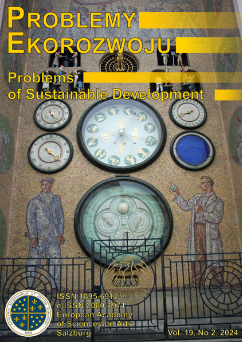The Effect of Green R&D Activities on China’s SO2 Emissions: Evidence from a Panel Threshold Model
Shuxing Chen
Southwestern University of Finance and Economics, Chengdu 611130, China (China)
Ke Liu
Southwestern University of Finance and Economics, Chengdu 611130, China (China)
Denglong Ding
Southwestern University of Finance and Economics, Chengdu 611130, China (China)
Zeyu Yue
Southwestern University of Finance and Economics, Chengdu 611130, China (China)
Zhu Bo
People’s Bank of China, Financial Research Office, Chengdu 610041, China (China)
Yuee Tang
chensx@swufe.edu.cnChengdu University of Technology, Chengdu 610059, China (China)
Abstract
Previous studies on the effectiveness of improving sustainable development have acknowledged the importance of domestic research and development (R&D) activities. However, these studies remain general and ambiguous because they assume that all R&D activities are related to energy-saving and sustainable development. The corresponding empirical evidence is scabrous and ambiguous. In this paper, we focus on the effect of green innovation R&D activities on SO2 emission which is an important greenhouse gas affect global climate change and eco-civilization. Considering that there is heterogeneity exists in the innovation activities, the R&D activities are divided into three performers with two purposes. The empirical results based on a Chinese inter-provincial dataset of 2000-2016 suggest that the green innovation R&D activities are crucial for the reduction of the SO2 emission. However, the innovation R&D activities of different purposes and performers show statistically differentiated effects on SO2 emission. The major positive effect of green innovation R&D activities on SO2 emissions reduction is mainly from enterprises and utility-type of R&D activities. A further study based on the panel threshold also indicates that effects of green innovation R&D activities on SO2 emissions are nonlinear, depending on the technology absorptive ability.
Keywords:
green innovation activities, SO2 emissions, technology absorptive ability, sustainable developmentReferences
CAI H.X, FAN R.G., 2019, Regional Total Factor Energy Efficiency Evaluation of China: The Perspective of Social Welfare, Sustainability,11(15): 4093.
DOI: https://doi.org/10.3390/su11154093
Google Scholar
DIETZ T., ROSA E.A., 1997, Effects of population and affluence on CO2 emissions, Proceedings of the National Academy of Sciences, 94(1):175-179.
DOI: https://doi.org/10.1073/pnas.94.1.175
Google Scholar
HUANG J.B., DU D., HAO Y., 2017, The driving forces of the change in China’s energy intensity: An empirical research using DEA-Malmquist and spatial panel estimations, Econ. Model., 65, 41-50.
DOI: https://doi.org/10.1016/j.econmod.2017.04.027
Google Scholar
LI L. B., HU J. L., 2012, Ecological total-factor energy efficiency of regions in China, Energy Policy, 46(2): 216-224.
DOI: https://doi.org/10.1016/j.enpol.2012.03.053
Google Scholar
LI Y., CHIU Y. H., LU L., 2018, Regional energy, CO2, and economic and air quality index performances in China: a meta-frontier approach, Energies, 11(8).
DOI: https://doi.org/10.3390/en11082119
Google Scholar
MENSAH C.N., LONG X., DAUDA L. et al., 2019, Technological innovation and green growth in the Organization for Economic Cooperation and Development economies, Journal of Cleaner Production, 240.
DOI: https://doi.org/10.1016/j.jclepro.2019.118204
Google Scholar
SHAFIEI S., SALIM R.A., 2014, Non-renewable and renewable energy consumption and CO2 emissions in OECD countries: A comparative analysis, Energy Policy, 66: 547-556.
DOI: https://doi.org/10.1016/j.enpol.2013.10.064
Google Scholar
SHUXING Ch., XIANGYANG D., JUNBING H., CHENG Ch., 2019, The Impact of Foreign and Indigenous Innovations on the Energy Intensity of Chinas Industries, Sustainability, 11(4): 1107.
DOI: https://doi.org/10.3390/su11041107
Google Scholar
STEINBERGER J. K., ROBERTS J. T., 2010, From constraint to sufficiency: The decoupling of energy and carbon from human needs, 1975-2005, Ecological Economics, 70(2): 425-433.
DOI: https://doi.org/10.1016/j.ecolecon.2010.09.014
Google Scholar
SHI-CHUN, X., YI-WEN L., YONG-MEI et al., 2019, Regional differences in nonlinear impacts of economic growth, export and fdi on air pollutants in China based on provincial panel data, Journal of Cleaner Production, 228: 455-466.
DOI: https://doi.org/10.1016/j.jclepro.2019.04.327
Google Scholar
TENG X., LU L.C., CHIU Y.H., 2019, Energy and emission reduction efficiency of China's industry sector: a non-radial directional distance function analysis, Carbon Management, 10(4): 333-347.
DOI: https://doi.org/10.1080/17583004.2019.1605481
Google Scholar
VOIGHT S., DE C. E., SCHYMURA M., VERDOLINI E., 2014, Energy intensity developments in 40 major economies: structural change or technology improvement? Energy Economics, 41: 47-62.
DOI: https://doi.org/10.1016/j.eneco.2013.10.015
Google Scholar
WEN L., LI Z.K., 2019, Driving forces of national and regional CO2 emissions in China combined IPAT-E and PLS-SEM model, Science of the Total Environment, 690: 237-247.
DOI: https://doi.org/10.1016/j.scitotenv.2019.06.370
Google Scholar
YORK R., ROSA E. A., DIETZ T., 2003, STIRPAT, IPAT and ImPACT: analytic tools for unpacking the driving forces of environmental impacts, Ecological Economics, 46(3): 351-365.
DOI: https://doi.org/10.1016/S0921-8009(03)00188-5
Google Scholar
YU H.Y., 2012, The influential factors of China's regional energy intensity and its spatial linkages: 1988- 2007, Energy Policy, 45: 583-593.
DOI: https://doi.org/10.1016/j.enpol.2012.03.009
Google Scholar
ZHANG N., KONG F., YU Y., 2015, Measuring ecological total-factor energy efficiency incorporating regional heterogeneities in China, Ecological indicators, 51: 65-172.
DOI: https://doi.org/10.1016/j.ecolind.2014.07.041
Google Scholar
ZHENG Y.M., QI J.H., CHEN X.L., 2011, The effect of increasing exports on industrial energy intensity in China, Energy Policy, 39: 2688-2698.
DOI: https://doi.org/10.1016/j.enpol.2011.02.038
Google Scholar
ZHENG-XIN, WANG DE-JUN Y., HONG-HAO et al., 2019, The influence of market reform on the CO2 emission efficiency of China, Journal of Cleaner Production, 225: 236-247.
DOI: https://doi.org/10.1016/j.jclepro.2019.03.303
Google Scholar
Authors
Shuxing ChenSouthwestern University of Finance and Economics, Chengdu 611130, China China
Authors
Ke LiuSouthwestern University of Finance and Economics, Chengdu 611130, China China
Authors
Denglong DingSouthwestern University of Finance and Economics, Chengdu 611130, China China
Authors
Zeyu YueSouthwestern University of Finance and Economics, Chengdu 611130, China China
Authors
Zhu BoPeople’s Bank of China, Financial Research Office, Chengdu 610041, China China
Statistics
Abstract views: 36PDF downloads: 13
License

This work is licensed under a Creative Commons Attribution-ShareAlike 4.0 International License.








